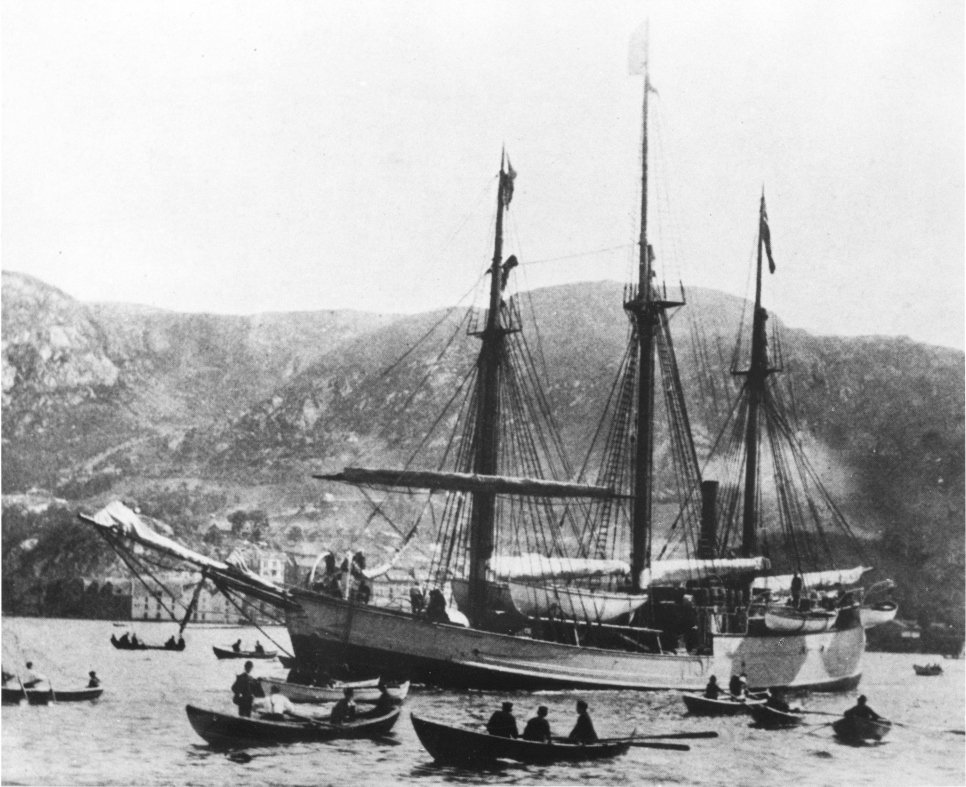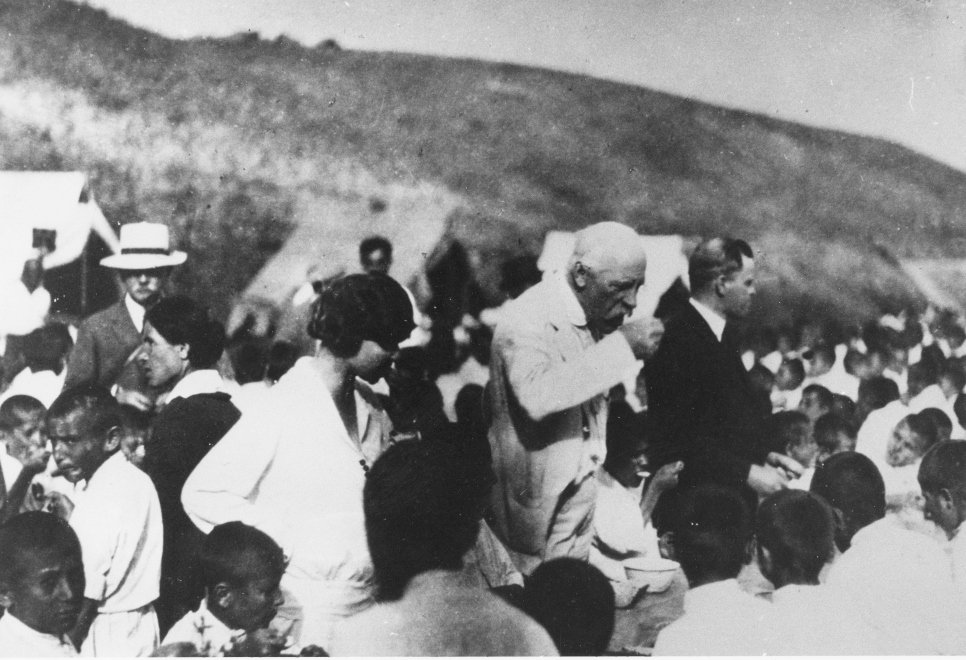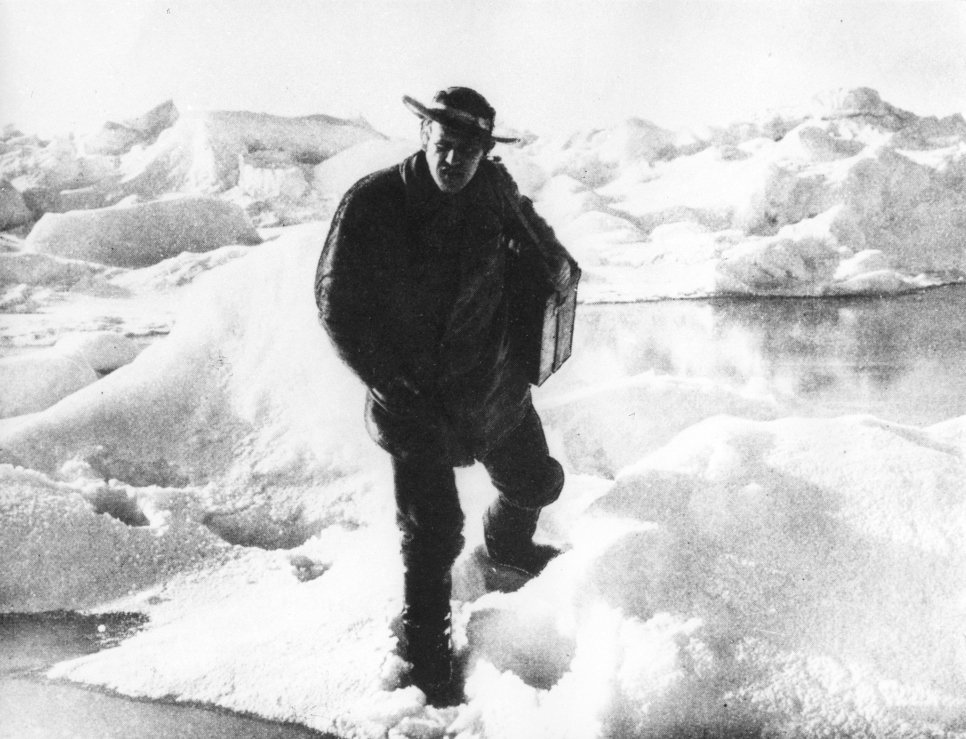Ahead of this year’s UNHCR Nansen Refugee Award, we look back at the life and achievements of the Norwegian pioneer who gave his name to the prize.
Fridtjof Nansen on board the "Correct" during his expedition to Siberia in 1913. © UNHCR
But who was Nansen? And how did a man who started his professional life investigating the anatomy of tiny marine worms end up addressing the humanitarian consequences of the First World War and the collapse of the Romanov, Hapsburg and Ottoman empires?

Fridtjof Nansen observes a solar eclipse during his Arctic expedition in April 1894. © UNHCR
The greatest polar explorer you’ve probably never heard of
Nansen’s achievements as a statesman and humanitarian were built on the fame and fortune he acquired as an intrepid and innovative explorer. His first venture into the Arctic Ocean came in 1882, when he was just 20 years old, on a sealing ship (though his main task was to study wildlife). In 1888, he made the first land crossing of Greenland – an achievement that made him a national hero.
But perhaps his most celebrated feat as an explorer was his expedition to the North Pole. Nansen set sail on the Fram, a ship he had specially built for the journey, in 1893 and didn’t return for three years. Although he did not make it to the Pole, he did set a record for the northernmost point on Earth yet reached.
This sparked full-on Nansen mania, both in Norway and abroad – notably in Britain. Among the explorers who sought his advice, blessing and funding were Roald Amundsen (who even borrowed the Fram for his expedition to the Antarctic), Ernest Shackleton and Robert Falcon Scott.

The sturdy vessel Fram, which supported Fridtjof Nansen on his famous 1893-1896 bid to reach the North Pole. © UNHCR
Transition to ambassador, statesman, and refugee champion
As Norway agitated to end its union with Sweden, Nansen was drafted into both the diplomatic offensive and the public relations campaign. After independence in 1905, he was made ambassador to Britain, where he was lionized by high society and royalty.
This was his springboard to wider international engagement after the First World War. Popular, famous and admired for his honesty and integrity, Nansen was entrusted with roles that more partisan figures could not have taken on. “Somehow, men of influence were attracted by Nansen’s personality,” wrote his biographer Roland Huntford.
Nansen was appointed the first High Commissioner for Refugees by the League of Nations in 1921, a post he held until his death in 1930. He immediately devoted himself to finding solutions for Russian emigres who fled after the Bolshevik Revolution; refugees from Greece and Türkiye displaced by the collapse of the Ottoman Empire and the Turkish war of independence, and fleeing Armenians.

In Armenia, Fridtjof Nansen tastes the food given to children. © UNHCR
Another centenary to celebrate: the Nansen passport
Nansen saw that one of the biggest problems facing refugees was the lack of internationally recognized identification papers. This was in large part because the fall of three empires almost simultaneously, and the new ideological animosities of the post-war era, meant the European map was being substantially redrawn and the countries of origin of some refugees ceased to exist. Notably, the new Soviet government rescinded the citizenship of all those who had fled abroad without its permission. As a result, millions of people who had fled their homes suddenly became stateless as well.
Nansen’s solution was the “Nansen passport”. First issued in 1922, it served as both an identity document and a travel permit allowing people to seek work in third countries beyond the borders of the state that was hosting them. Around 450,000 Russians and Armenians received Nansen passports. Those who could afford it were asked to pay five gold francs to obtain one. By the time the passports were discontinued in 1942, more than 50 countries had recognized them.

Travel documents and a copy of the Convention relating to the status of refugees. © UNHCR
Nansen’s humanitarian work extended well beyond help for refugees
As his Nobel citation indicates, Nansen was engaged around the same time in numerous other activities to help others in dire need of humanitarian assistance. This included efforts along with the International Committee of the Red Cross (ICRC) to repatriate roughly 430,000 prisoners of war, mostly from Soviet Russia, Germany and other defeated powers such as Austria and Hungary, though several other nationalities were also involved. Given practically no budget, he proved a highly effective fundraiser and leader for the cause.
Nansen was also tasked with organizing a relief effort for millions of Russians affected by famine in 1921-22. Again working with the ICRC, he coordinated the procurement and delivery of food aid to Russia up until 1924 – small amounts compared to the American Relief Administration, but nonetheless life-saving.
In his three-pronged role as High Commissioner for Refugees, High Commissioner for Relief, and High Commissioner for the Repatriation of Prisoners of War, Nansen consistently appealed to states to act according to higher ideals. “No practical politics are conceivable in a civilised society if not based on brotherly love, reciprocity, helpfulness, confidence…,” he once wrote. “Brotherly love is practical politics.”

Nansen, in his role as High Commissioner for Refugees, examines the flour with which bread will be made for famine relief in Russia. © UNHCR
In fact, he won the Nobel Peace Prize twice (sort of)
The 1938 Nobel Peace Prize was awarded to the Nansen International Office for Refugees, set up after Nansen’s death in 1930, “for having carried on the work of Fridtjof Nansen to the benefit of refugees across Europe”. The Office ran refugee camps, issued Nansen passports, and helped to provide visas, jobs, medicine and food.
In 1954, UNHCR, the UN Refugee Agency, established a prize in Nansen’s name
The UNHCR Nansen Refugee Award is given to a person or an organization with exceptional dedication and commitment in supporting people who are refugees, internally displaced or stateless. The first laureate was Eleanor Roosevelt, the first chair of the UN Human Rights Commission. Other winners include US Senator Edward Kennedy, opera singer Luciano Pavarotti, humanitarian Graça Machel, Médecins Sans Frontières and the People of Canada, though the award is just as likely to go to an unheralded grassroots organization or an individual. Since 2017, UNHCR has also recognized regional winners.
The passport and prize aren’t the only things to bear Nansen’s name
Fridtjof Nansen had a mind that was both brilliant and restless. Without a yearning for polar exploration, a scientific career would have been his for the taking. He was one of the first people to propose the theory of neurons – that the nervous system is composed of discrete units rather than one connected system – and gave his name to “Nansen fibres” in the spinal cord.
Two of the marine worms (myzostomes) he studied were later named M. Giganteum Nansen and M. Grafi Nansen; the Nansen-Petterson water bottle was used by oceanographers to collect deep-sea water samples; a visit to Russia led to the naming of Nansenovka railway station on an offshoot of the Trans-Siberian railway; and there is Mount Nansen in Antarctica, and another in the Arctic region.
This is not to mention innumerable innovations he made or inspired in the field of polar exploration – skis, sledges, stoves, shoes and clothes, sleeping bags, diet, ship design…

Fridtjof Nansen during his legendary 1893-1896 Arctic expedition. © UNHCR
A character of conviction and courage – but also complexity
Magnetic, inspirational, charismatic, iron-willed and brilliant company. Also, gloomy, introspective, self-absorbed, and perpetually convinced he was right. Nansen’s biographer describes a man who swung from light to shade and back again – he could be irresistibly charming and persuasive, but was also capable of high-handed moralising. Aware of his considerable talents, he often fretted that he had not done enough with them, and had been pulled in too many directions to make a truly great contribution to one field.
Yet he was trusted and respected as a man of principle who sought to help those who needed it most, an idealist willing to find pragmatic solutions to the chaotic aftermath of the First World War. As Thorvald Stoltenberg, a Norwegian politician and former UN High Commissioner for Refugees, put it: “With idealism, vigour, humanity and vision Nansen pursued his unshakable conviction that mankind must be spared the recurrence of such devastation and misery.”
Share on Facebook Share on Twitter